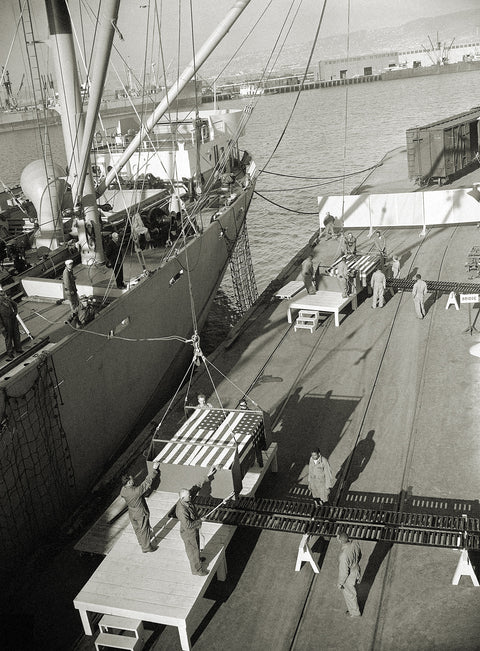
New Study Looks at a Grim Mission: Bringing WWII’s Dead Back Home
On October 10, 1947, the U.S. Army funeral ship Honda Knot docked in Oakland, California, delivering 3,027 caskets as a military band played “Taps” and Verdi’s “Requiem.” Inside were the remains of Americans who had died in the Pacific — the first to be repatriated from the battlefields of World War II. On the 75th anniversary of that first mission, the massive logistical campaign to bring 171,000 fallen Americans home has gone unremembered.
Kim Clarke, a writer in Michigan, is working to change that. For 15 years, Clarke, who is at work on a book about the program, has been poring over the records of the American Graves Registration Service, letters from distraught families, military personnel records and oral histories. “I believe it’s a largely unknown chapter of the war,” she told World War II.
Her mission began when she started researching her own grandfather, Corporal Delbert Trueman, killed at age 27 when his B-24 bomber was shot down over Vienna on October 17, 1944. Clarke became fascinated by the process that brought the fallen home. “I’ve made it a point,” she said, “to learn about the work of the embalmers, chaplains, army transport crews, casket manufacturers, military escorts, elected leaders—all those who were involved with returning the dead.” Her grandfather is now buried in a cemetery in Marion, Indiana.
During the war, the American military was unable to ship home the remains of those who fell overseas; the money and transport ships couldn’t be spared from the fight. The dead were buried in temporary military cemeteries in Europe and the Pacific. Once the war ended, families could choose to bring the fallen home for reburial or leave them undisturbed overseas. Some thought that moving the bodies amounted to desecration.
But many wanted their loved ones brought home. First Lieutenant Leonard T. Mojica, 21, was the pilot of the B-24 in which Clarke’s grandfather died. Mojica, too, was killed when the plane went down. He was the only child of a divorced mother, Juanita Harding, and she was desperate for his body to come home. In pleas to military officials, she offered to sell her trailer home to pay for his return. “She was literally willing to give up everything she owned,” Clarke says. “Her letters are so incredibly sad but also filled with such love for her son.”
this article first appeared in world war II magazine
“The strain of waiting is rather hard to put into words,” Harding wrote in a May 1, 1948, letter to the army’s quartermaster general. “I lost him in October 1944 and I’ve been waiting for what [seems] like a thousand years to bring him home to rest.”
She got her wish. Mojica’s remains were repatriated in December 1948 and buried in Los Angeles’s Holy Cross Cemetery in February 1949. The government paid to bring the body home and allocated $75 for funeral expenses.
The $163 million repatriation program lasted from 1947, with the arrival of the Honda Knot , until 1951. More than 171,000 bodies — 60 percent of America’s World War II combat dead — were brought back from 86 countries on six continents. The remainder were laid to rest in permanent overseas cemeteries such as the Henri-Chapelle American Cemetery in Belgium. “For many families, the war did not end in 1945,” Clarke says. “Thousands of people, military and civilian, dedicated themselves, during the war and afterward, to plan for the repatriation and see that the dead were recovered and returned with honor.”
This article appeared in the Autumn 2022 issue of World War II.
